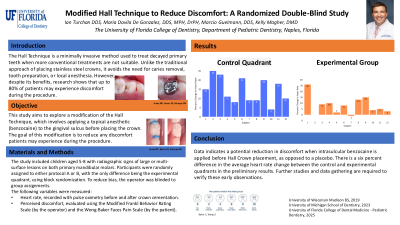Restorative
401 - Modified Hall Technique to Reduce Discomfort: A Randomized Double-Blind Study
Saturday, May 24, 2025
2:30 PM - 2:45 PM MDT

Has Audio

Ian Turchan, DDS
Pediatric Dental Resident
University of Florida
Univeristy of Florida
Naples, Florida, United States- MC
Matthew Cooke, DDS, MD, MPH
Program director
University of Florida
Gainesville, Florida, United States
Presenting Author(s)
Program Director(s)
Abstract:
Purpose: Stainless steel crowns placed using the Hall Technique provide a minimally invasive approach to treating dental caries in primary molars. The technique requires no caries removal, tooth preparation, or local anesthesia, making it particularly beneficial for anxious or pre-cooperative children. However, some patients have still reported discomfort during cementation of the crown. This study aimed to enhance patient comfort by modifying the Hall Technique to include the application of topical anesthesia in the intrasulcular area before cementation of the crown.
Methods: Children aged 5-8 years with large or multi-surface lesions on at least one primary mandibular molar on the lower right and lower left quadrant are recruited. Experimental variables are assessed using the following methods: 1. Recording patients' heart rates before and after crown cementation with pulse oximetry. 2. Evaluating perceived patient discomfort through the Modified Frankl Behavior Rating Scale according to the operator, and the Wong Baker Faces Pain Scale, according to the patient. The clinical data recorded will undergo statistical analysis once a sample of 20 participants is reached.
Results: Data collection is currently underway, with 14 patients enrolled to date.
Conclusion: This study aims to refine an already minimally invasive technique by further reducing discomfort in young or anxious patients. Enhancing patient comfort can significantly improve their overall experience with dentistry, fostering greater trust and acceptance of future treatments.
Identify Supporting Agency and Grant Number:
Purpose: Stainless steel crowns placed using the Hall Technique provide a minimally invasive approach to treating dental caries in primary molars. The technique requires no caries removal, tooth preparation, or local anesthesia, making it particularly beneficial for anxious or pre-cooperative children. However, some patients have still reported discomfort during cementation of the crown. This study aimed to enhance patient comfort by modifying the Hall Technique to include the application of topical anesthesia in the intrasulcular area before cementation of the crown.
Methods: Children aged 5-8 years with large or multi-surface lesions on at least one primary mandibular molar on the lower right and lower left quadrant are recruited. Experimental variables are assessed using the following methods: 1. Recording patients' heart rates before and after crown cementation with pulse oximetry. 2. Evaluating perceived patient discomfort through the Modified Frankl Behavior Rating Scale according to the operator, and the Wong Baker Faces Pain Scale, according to the patient. The clinical data recorded will undergo statistical analysis once a sample of 20 participants is reached.
Results: Data collection is currently underway, with 14 patients enrolled to date.
Conclusion: This study aims to refine an already minimally invasive technique by further reducing discomfort in young or anxious patients. Enhancing patient comfort can significantly improve their overall experience with dentistry, fostering greater trust and acceptance of future treatments.
Identify Supporting Agency and Grant Number:

.jpg)